#Weekly Shōnen Sunday
Text
Happy New Year

Bye bye 2023.The New year,2024 just came:)
#happy new year#高橋 留美子#Takahashi Rumiko#Urusei Yatsura Lum#うる星やつら#ラム うる星やつら#romantic comedy#romcom#school life#science fiction#Shogakukan#株式会社小学館#Weekly Shōnen Sunday#週刊少年サンデー#Shōnen#少年漫画
8 notes
·
View notes
Photo

'First car of my life': Song Joong-ki, red carpet in tuxedo...hot shouts
2 notes
·
View notes
Text
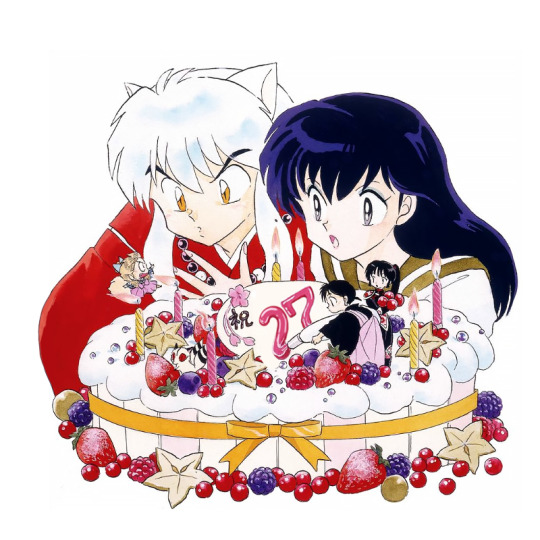
Happy 27th Anniversary, Inuyasha!
Written and illustrated by Rumiko Takahashi, Inuyasha first debuted in Shogakukan's Weekly Shōnen Sunday (issue #50) on November 13th, 1996 ☆
#there was ONE year I could make this edit lest I wait another TEN#baby Anisa was 4. sound off where/when you were :D#my edit#inuyasha x kagome#miroku x sango#inuyasha#kagome#kagome higurashi#miroku#sango#shippo#kirara#inuyasha manga#inuyasha edit#manga edit#shounen#犬夜叉#rumiko takahashi#shounen sunday 2003#anisa reads inuyasha
640 notes
·
View notes
Text


Weekly Shōnen Sunday No. 39
September 1978
#first issue of uy#rumiko takahashi#urusei Yatsura#those obnoxious aliens#weekly shonen sunday#高橋 留美子#うる星やつら#rumic world#manga#70s#retro manga#go nagai#Lamù#shounen manga#lum invader#some accounts date the issue at 30th august#most say September#this and next posts will be dated with the month only
71 notes
·
View notes
Note
This is honestly just me venting, but it seems like everyone online keeps rehashing about how anime has a problem with girls and women in the writing department, but they only ever use shounen for their examples, with maybe a seinen series thrown in to mix things up. Is the writing of women in MHA or Naruto or Inuyasha perfect? No, but these are literally series made for teenage boys all published in Jump. And please for the love of god stop asking why there isn't a lot of shoujo or jousei anime recently.
Animation is expensive and time-consuming. The average cost for a 12-episode show is around 10 million USD. It's a huge investment. The main purpose of an anime is to advertise to get more people to buy the manga and merch, which helps the publishers and authors more than the anime. To even be considered for an upcoming anime, production companies and publishers will look to see how popular a series is. So, if all people want to buy is seinen and shounen manga, the vast majority of anime made will be shounen and seinen. If you want more anime made that is shoujo or jousei, you have to buy shoujo and jousei manga. It's that simple. There were higher sales for shoujo and jousei manga in the 90s, 2000s, and early 2010s. The shounen fans buy manga. That's the difference.
--
I thought Inuyasha was all right at women, at least in the manga—like most of her work. And it ran in Weekly Shōnen Sunday. But yes.
Also, some series are more likely to get drama adaptations than anime ones. If one doesn't like live action, that's sad, but them's the breaks. I quite enjoyed the Kei x Yaku drama and was surprised that what seemed like a relatively obscure series got one. It must be more popular than I think.
People spend too much time crying about changing the things they're already watching rather than exploring what else they could watch.
71 notes
·
View notes
Text
1964-Cyborg 009 starting serialization

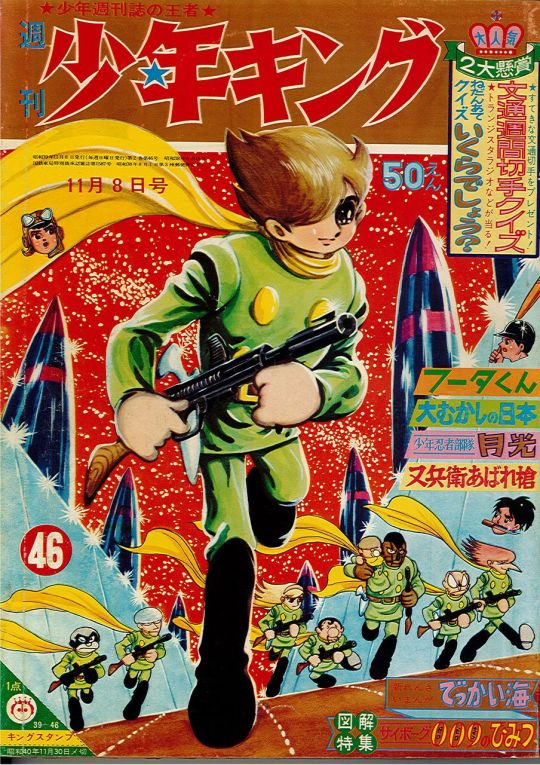
Cyborg 009 (Japanese: サイボーグ・ゼロ・ゼロ・ナイン, Hepburn: Saibōgu Zero-Zero-Nain) is a Japanese science fiction manga created by Shotaro Ishinomori. It was serialized in many different Japanese magazines, including Monthly Shōnen King, Weekly Shōnen Magazine, Shōnen Big Comic, COM, Shōjo Comic, Weekly Shōnen Sunday, Monthly Shōnen Jump, and Monthly Comic Nora. In 2012, comiXology acquired the digital distribution rights to Shotaro Ishinomori's catalogue, including Cyborg 009.

Cyborg 009Day is an unofficial holiday celebrated in Japan by fans of Cyborg 009 on July 19th. The day marks the anniversary of when Cyborg 009 was first published in 1964.
Observers honor Shotaro Ishinomori's career by cosplaying, visiting the Ishinomori Manga Museum, revisiting the animes, films and manga and drawing artwork of their favorite characters.
14 notes
·
View notes
Text
When is Ranma ½ set?
There are two data points that I like to use to answer this question.
One is this shot from the anime. I can't recall which episode or special or whatever it's from, but it specifies October 1990. I can't quite tell if it's 21 or 31 but quite that much precision isn't needed.

The other is the Super Famicom.
See, in the Jizō Statue arc, there's a shot of Shampoo playing on a Super Famicom. That came out on November 21, 1990.

And you know the Jizō Statue arc is set in winter since the very plot is kicked off by a nice warm scarf.
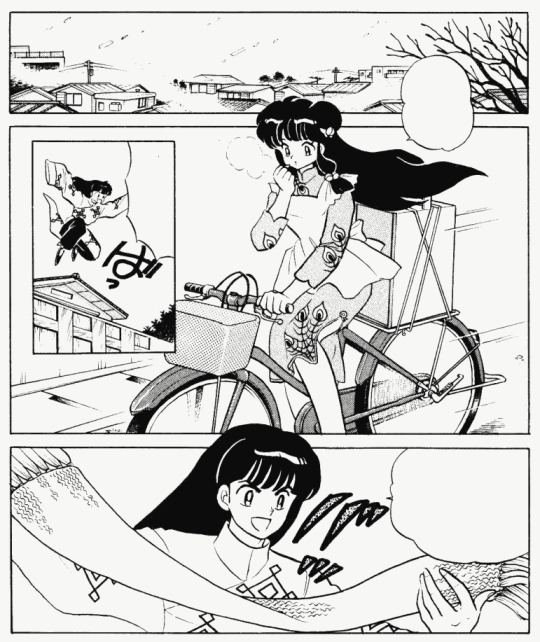
So I may not know where along the timeline that anime screenshot is from, but I can tell you that assuming the manga itself is internally in chronological order, the second half of volume 33 is set some time but not too far after November 21, 1990, and you can work back from there.
My mission therefore: go through the manga from volume 1 to at least 33, to track the winters and figure out how many years before 1990 it started.
Lets imagine the answer is 1987. That's when the manga first appeared in Shōnen Sunday. It ended in 1996. If the first chapter ends up being set in 1987, three years passed between 33 volumes... and six years for the last five? That can't be right, but we'll see!
Let's say we assume chapter 1 is set in 1987 and count the winters up to the Jizō arc...
Okay. By my count, the story can be set in 1987 in volume 1, and have enough time pass for the SFC to come out by volume 30:
Volume 1: Manga starts publication in 1987.
Volume 11: Super Soba, New Years 1988 to 1989.
Volume 20: Shampoo and Maomolin, NY 1989 to 1990.
Volume 30: Hinako's Super Famicom, because there are two appearances of the damn things.
That's counting only the volumes before #30 that have stories explicitly set on New Years, and that's enough to make the Super Famicom fit in chronologically. It has to be at least 1990 by then, and if you count the winters it shifts up into 1991, if not later.
But! There's a gap in my earlier conclusion, where volume 1 is in 1987 but 11 has New Years Eve 1988 to 1989. What happened to NYE 1987-88? Well, thankfully, it still works out if you count the winters. There's two possible winters in volumes 3 and 7, with a summer in 6 and 11. Take your pick as to which of these count. If even one does, you get to 1990 in volume 20, or even as early as volume 16. Which means I need to check me some publication dates!
In terms of publication dates, volume 30 came out in 1994. Clear cut, right? First, there's two releases. Weekly Shōnen Sunday, and the Shogakukan tankōbon. These volume numbers I've been using all this time are tankōbon. And those started in March 1988, not August 1987.
Easy conversion then is to subtract half a year. Okay. So the chapter with Hinako's SFC came out early 1994 instead. Cool. Volume 1 came out in March 1988, 6 in December 1988. Volume 7 was May 1989... It's actually pretty hard to figure this out when you don't have publication dates for the Shōnen Sunday serialization, but clearly, the story starts in 1987, and that's all that really matters.
And what matters to me is that enough time passes for them to have Super Famicoms.
12 notes
·
View notes
Photo

Zatch Bell - Um dos melhores animes já feitos
Zatch Bell, conhecido no Japão como Konjiki no Gash(金色のガッシュ!!), é uma série de mangá escrita por Makoto Raiku, serializada na revista de mangá shōnen da Shogakukan, Weekly Shōnen Sunday, entre janeiro de 2001 e dezembro de 2007, com seus capítulos coletados em trinta e três volumes tankōbon. No enredo da série, o personagem titular, Zatch Bell, uma criatura mística denominada “Mamodo”, faz parceria com um adolescente problemático chamado Kiyomaru Takamine, que vive fugindo às aulas na escola. Ou seja, o pequeno loiro bota muita moral no moreno rebelde. A cada mil anos é iniciado um torneio no mundo dos Mamodos. O vencedor, que sobreviver ao mundo humano, será declarado o Rei dos Mamodos. Zatch quer se tornar um “generoso rei”. Durante a jornada, Kiyo e Zatch conhecem outros Mamodos, e os parceiros humanos deles, tais como Brago, e a parceira humana dele, a nobre francesa Sherry Belmont. O protagonista, Zatch, veio do mundo dos Mamodos para o mundo humano sem lembranças do passado dele, presumidamente apagadas por Zeno Bell, o irmãozinho bastardo do protagonista. Zatch também é o portador do poderoso feitiço Bao Zakeruga, uma técnica especial com alto poder destrutivo. Zatch Bell foi adaptado para o formato anime em 2003 pela Toei Animation e a série foi exibida no Fuji TV de abril de 2003 até março de 2006. Apesar de ser um anime bem feito, a maior decepção é saber que o final do anime não seja o mesmo que o do mangá. Mesmo assim vale a pena assistir...
7 notes
·
View notes
Text

Il manga SuperString di Boichi e In-Wan Youn va di nuovo in pausa
Il manga tornerà nel secondo numero del 2024 di Weekly Shōnen Sunday.
Info:--> https://www.gonagaiworld.com/il-manga-superstring-di-boichi-e-in-wan-youn-va-di-nuovo-in-pausa/?feed_id=410295&_unique_id=654e61d2407a4
#Boichi #Manga #SuperString #SuperStringIsekaiKenbunroku
2 notes
·
View notes
Text
Orochi (おろち)

Written and illustrated by Kazuo Umezu in Weekly Shōnen Sunday from June 1969 to August 1970. Orochi, a perpetually young-looking woman with mysterious abilities who takes it upon herself to observe the lives of different individuals who catch her fancy, from afar. The story contains several varying elements such as paranormal and psychological themes.
The art is eerie & dark. It literally made me shiver & I don’t like that feeling, I couldn’t even finished reading it. I don’t really read horror manga like that, I would like to sleep at night…The cover art is amazing, it really pulls you in. Also, this is a hardcover edition & it’s beautiful. I want some shojo series like this, that would be nice. If you like horror/supernatural manga then this is for you.

Thank you @vizmediaofficial for sending this manga my way. I was not expecting this, made my heart jump.
✨Insta📸 & Tiktok @luziiannne ✨
#orochi#manga#anime#shonen sunday#shonenjump#kazuo umezu#horror manga#supernatural#booklr#漫画#manga review#vizmedia#comic books#graphic novel#books and literature#books#bibliophile#manga books#horror series#comics#おろち#orochi manga
8 notes
·
View notes
Text
Yuta and Mana:)
Yuta and Mana do have height difference. It's no random that when they're walking side by side, Mana always walks on the railings, she likes to be on Top,to be taller than him. Due to Mana is for Power.




#Takahashi Rumiko#高橋 留美子#人魚シリーズ#Mermaid Saga manga#Horror fantasy#Supernatural#historical drama#Romance#Strong female lead#Rumicworld#Rumic couple#Shōnen Sunday Comics Special#Shonen manga#少年漫画#Shogakukan manga#株式会社小学館#Sunday Shonan Zokan#週刊少年サンデーS#Weekly Shōnen Sunday#週刊少年サンデー#Mermaid Saga Yuta and Mana#湧太#真魚#Immortality
9 notes
·
View notes
Photo

BLACKPINK ROSSE, Cannes Red Carpet stepped on... eye-catching in halter-neck dress
3 notes
·
View notes
Text
Dynasty Warriors Inspired Game Idea (Manga's)
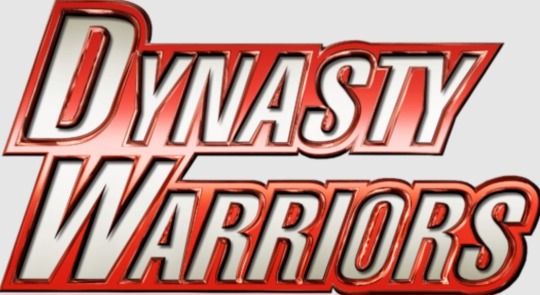




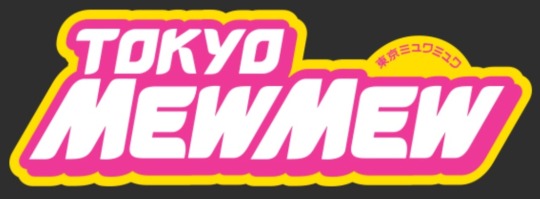




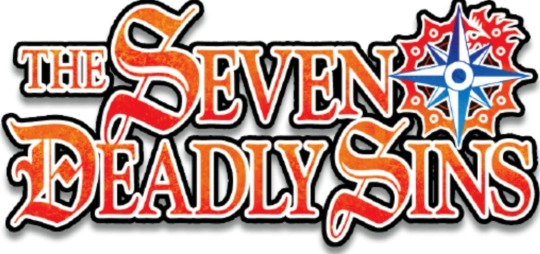
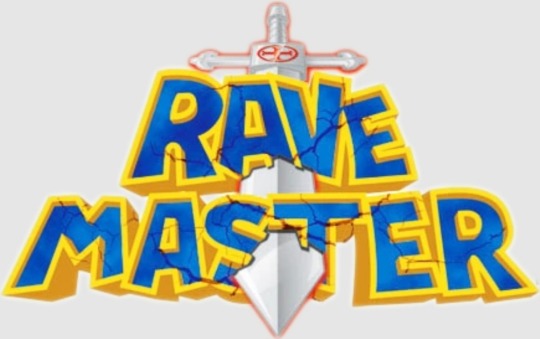
Here's an example of another Dynasty Warriors Inspired 'Crossover' Game, One Piece: Pirate Warriors 4;
youtube
#Dynasty Warriors#Naruto (Series)#My Hero Academia#Sailor Moon (Series)#Tokyo Mew Mew/Mew Mew Power#Soul Eater (Series)#Akame ga Kill!#InuYasha (Series)#Märchen Awakens Romance/MÄR#The Seven Deadly Sins (Manga)#Rave Master#Crossover#Question Poll
1 note
·
View note
Text


Weekly Shōnen Sunday No. 50
November 1996
#first issue of inuyasha#rumiko takahashi#inuyasha#Kagome Higurashi#weekly shonen sunday#高橋 留美子#犬夜叉#manga#90s#retro manga#shounen manga
65 notes
·
View notes
Text
Animation Night 115: Early Mamoru Oshii
Hi friends! It’s Thursday, the sun is no longer trying to kill me, let’s enjoy some animated films!
So, Mamoru Oshii! Know him, maybe love him - he’s the guy who makes slooooow-paced serious philosophical anime films in near future sci-fi settings, and he hangs out with the best realist animators at Headgear/Production I.G. right? But what was he before he was that?
Funnily enough, our boy Oshii made the first OVA. Not, mind you, the first successful OVA - that honour goes to Megazone 23, which we watched on Animation Night 103. (There is much more to say about the later episodes of Megazone 23, with the second especially being an interesting unsuccessful experiment in what would become the ‘realist’ style, but I’ll save that for the day we cover Yasuomi Umetsu.)
So, if Oshii got in there first, what was his contribution? That is Dallos - but I’m getting ahead of myself~

...because to begin, before he was the Ghost in the Shell guy, indeed before he was Patlabor guy, Mamoru Oshii was the Urusei Yatsura guy!
So, Urusei Yatsura. This is one of those big classics. It began as a Weekly Shōnen Sunday manga running from '78 to ‘87 by Rumiko Takahashi, also known for other household-name classics like Ranma 1/2 and Inuyusha. The series is, so far as I understand, mostly light-hearted comedy about the lives of a horny boy and a hornéd alien who get married for kind of silly reasons.
So, the anime! Our boy Oshii entered the anime industry shortly after graduation in 1977, at Tatsunoko Productions, a studio with a lot of history that you can go read (drink) Matteo Watzky write about with a lot of interesting detail! In 1980, he jumped ship to Pierrot. I’m not sure Rumiko Takahashi was quite such a big name then as she is now... whatever the reason, this relatively untested young director got put in charge of the show, and absolutely killed it...
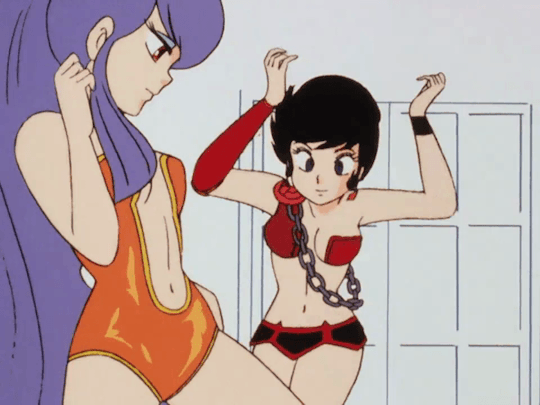
Here is how Watzky introduces Urusei Yatsura...
Urusei Yatsura is probably one of the defining works of anime history at large, a central piece of otaku history, and the show that truly launched many of the stylistic and visual trends we still associate with “80s anime”. Its format—a long-running comedy series—placed it in the lineage of the great absurd A Pro comedies of the 70’s like Dokonjo Gaeru or Ganso Tensai Bakabon, and their descendants such as Doraemon. However, Urusei Yatsura differed from these on at least three points: its SF setting, its romantic comedy genre, and its parodic aspect. These were all the elements needed to cater to the burgeoning population of otaku and their sensibility for cool mecha, cute girls, and pop culture references.
In terms of production, the series was the directorial debut of yet another young visionary: thirty-year-old Mamoru Oshii. Despite many conflicts with the mangaka Rumiko Takahashi, he led the show in unexpected and experimental directions, and played a large part in giving the young Kanada-style animators a place to completely and freely express themselves, thereby largely contributing to the stylistic revolution that would take anime by storm. Along with him, the other major members of the staff who initially worked with the Kanada school were episode director Keiji Hayakawa and animation director Asami Endô.
Of course, a director alone very much doesn’t make a TV show. And what made Urusei Yatsura so successful was being, essentially, the flagship of Kanada-school animation, as (once again) Watzky documents here. In particular, Watzky’s article discusses two of Kanada’s protégés who worked with him at Studio Z2/Z3, Masahito Yamashita and Shinsaku Kōzuma.
To summarise, Yamashita excelled at effects animation, developing Kanada’s characteristic ‘liquid fire’ in a more angular, contrasting direction over the course of the 1980 version of Tetsujin 28-go (for example). And Kōzuma was following Kanada’s clever use of a highly varied framerate in character animation to help the extreme poses pop, as well as developing his own style of explosions (kind of a theme, here!)

Oshii was wise enough to recognise the potential in the wild, off-model Kanada school antics, and Yamashita and Kōzuma increasingly became prominent across the show’s run. Just as important was his fellow Tatsukonoko alumnus Motosuke Takahashi, once called “Pierrot’s trump card” by the director, whose loose, extremely clear style of character animation earned praise from Miyazaki as well; like the Kanada school animators he enjoyed tricks like background animation, but tended to prefer a steady, fluid approach with a more even framerate - though in an interesting cross-section of artistic development, his style gradually drifted towards his Kanada-school peers over the show’s run.
And so many others who worked on Urusei Yatsura would go on to make other significant works in the 80s: Katsuhiko Nishijima, director of Project A-ko, and prolific character designer Toshiki Hirano, who I gave an entire Animation Night a couple months ago.
The problem with something of the sheer scale of Urusei Yatsura, though, is that there’s far too much to cram into one Animation Night. So, rather arbitrarily, I’m going to pull out the first of the movies that spun off from the TV show, Only You, directed by Oshii in 1983. And this film is apparently the favourite of Rumiko Takahashi herself, the one she considers truest to the manga, so that’s a nice extra. But to set context, I’ll also try and squeeze in a little of the TV show...

Now then, what of Dallos? After a couple of years of redefining anime with Urusei Yatsura, Studio Pierrot must have been feeling pretty confident, and decided to go for a sci-fi series to compete with the mighty Gundam. However, the funders Bandai decided it wouldn’t sell many toys with it and so shut down the project with just four episodes. This meant the scale of it was in an awkward place between a feature film and a TV series, so Bandai, or Pierrot (my sources are a little contradictory here and I don’t have time to dig in to which is right!) decided to try out going direct to this exciting new “home video” market that was suddenly all the rage in Japan.
The writer-director team consisted of Oshii and his mentor Hisayaki Toriumi, also of Tatsunoko, known for works like Science Ninja Team Gatchaman and (notable to me if only because its OP is a total earworm) Japanese-French collab The Mysterious Cities of Gold. The film is set on a moon colony which stages a rebellion, and the film takes inspiration from live action works like The Battle of Algiers (1966) (surprisingly relevant to last week!), by way of Heinlein. The rebels are in a hopeless situation, outside a mysterious artefact ‘Dallas’ of unknown powers.
The lack of a need to flog toys allows the story to go somewhere a bit more complex than other mecha anime of the time, and this is apparently the main strength of the project. Despite the grand geopolitical backdrop, it’s a relatively small scale and bleak story of people caught up in the conflict. It sounds honestly very compelling.
There’s some neat touches in the animation, like its portrayal of zero-gravity, and a level of violence that wouldn’t pass on TV, and some truly impressive moments where Yamashita gets to flex his talents at mecha and effects. Unfortunately I don’t have any sort of detailed history of the animation to hand, beyond that it seems to mostly share the same crew as Urusei Yatsura.
Oshii’s direction style isn’t yet in full effect, although you can apparently already see hints of it in moments like the aftermath of a battle. But this would probably be the first time he could indulge in the kind of sci-fi mecha story he would end up spending his whole career on, so it should be really interesting to see.
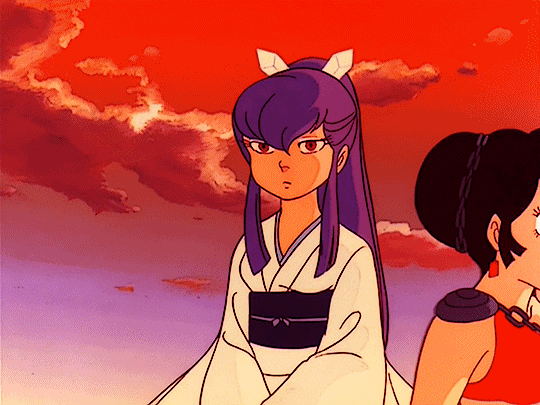
So, without further ado, let’s begin Animation Night 115! And hopefully soon I can show you more of Urusei Yatsura, once I think of a good way to organise it~
Animation Night 115 will be going live now at picarto.tv/canmom! Films will be starting in about 30 minutes most likely, see you there!
5 notes
·
View notes
